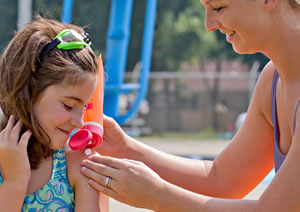Visitors and fellow staff members should protect themselves from the sun by wearing sun protection items, like hats with a wide brim, and protective clothing.
Nearly 5 million people are treated for skin cancer each year in the United States, at an estimated annual cost of $8.1 billion. Skin cancer can be serious, expensive, and sometimes even deadly. Skin cancer cases continue to increase in the United States. Fortunately, most skin cancers can be prevented.
 Applying sunscreen regularly is important, but it shouldn’t be your only defense against the sun.
Pool Cool is a sun-safety education program for children aged 5 to 10 and their parents, as well as for pool staff and other pool users. It is being used at public pools across the United States, including the Ivywild Pool in Boise, Idaho.
“As a result of our pool’s participation in the Pool Cool program, we helped create healthy habits for our community and our staff,” said Drew Williams, facility manager of Ivywild Pool. “Our outdoor pool is a popular destination during the hot summer months in Idaho, so we reach many children and adults through the program. Our swimming instructors are able to easily combine sun-safety lessons with swimming skills, so participants can enjoy healthy, safe fun in the pool.”
“In addition, the training is great for our lifeguards, who are exposed to the strong sun all summer,” Williams added. “Since participating in Pool Cool, our lifeguards have changed their habits for the better. It’s now cool to apply sunscreen regularly and wear protective clothing as a barrier from harmful UV rays.”
To find a sun-safety program for your park or recreational area, visit the National Cancer Institute’s RTIPs website.
Applying sunscreen regularly is important, but it shouldn’t be your only defense against the sun.
Pool Cool is a sun-safety education program for children aged 5 to 10 and their parents, as well as for pool staff and other pool users. It is being used at public pools across the United States, including the Ivywild Pool in Boise, Idaho.
“As a result of our pool’s participation in the Pool Cool program, we helped create healthy habits for our community and our staff,” said Drew Williams, facility manager of Ivywild Pool. “Our outdoor pool is a popular destination during the hot summer months in Idaho, so we reach many children and adults through the program. Our swimming instructors are able to easily combine sun-safety lessons with swimming skills, so participants can enjoy healthy, safe fun in the pool.”
“In addition, the training is great for our lifeguards, who are exposed to the strong sun all summer,” Williams added. “Since participating in Pool Cool, our lifeguards have changed their habits for the better. It’s now cool to apply sunscreen regularly and wear protective clothing as a barrier from harmful UV rays.”
To find a sun-safety program for your park or recreational area, visit the National Cancer Institute’s RTIPs website.
 Broad spectrum sunscreen with an SPF of 15 or higher is important, but it shouldn’t be your only defense against the sun. For the best protection, use shade, clothing, a hat with a wide brim, and sunglasses, as well as sunscreen.
Broad spectrum sunscreen with an SPF of 15 or higher is important, but it shouldn’t be your only defense against the sun. For the best protection, use shade, clothing, a hat with a wide brim, and sunglasses, as well as sunscreen.
- Ultraviolet (UV) rays—from the sun or from artificial sources like tanning beds—are known to cause skin cancer.
BE AWARE OF RISKS
Visitors and staff of outdoor recreational areas are at risk of getting too much sun exposure for many reasons. For example—- Visitors and staff often spend long hours outdoors in the sun.
- Reflection from sand, water, or snow can increase total sun exposure.
- It’s easy to forget about sun protection during fun outdoor activities.
USE THESE SUN-SAFE STRATEGIES
UV rays are strongest- From late morning through mid-afternoon.
- Near the equator.
- During summer months.
- At high altitudes.
INCREASE SHADE
- Use CDC’s Shade Planning for America’s Schools pdf icon[PDF-975KB] in your shade-planning efforts. This resource was designed for schools, but it has tips that apply to any outdoor recreational setting.
- Provide shade in high-use areas. Trees, buildings, canopies, umbrellas, shelters, and other shade structures can protect people from too much sun exposure.
- Try to move activities to shaded areas or schedule activities during low-UV times of day (usually early morning or late afternoon).
- Make sure that plans for new outdoor recreational spaces include shade.
MAKE OTHER FORMS OF SUN PROTECTION AVAILABLE
- Sell sun protection items, like hats with a wide brim, protective clothing, and umbrellas. These items can support healthy behaviors and bring in additional revenue.
- Provide broad spectrum sunscreen with an SPF of 15 or higher, and post instructions for proper use.
ENCOURAGE VISITORS AND STAFF TO USE SUN PROTECTION
- Create and enforce policies for sun protection by staff.
- Encourage recreation instructors and staff to teach and model sun safety behaviors.
- Post signs that remind visitors to protect themselves by using sun-safety strategies that work.
- Provide breaks during activities to give participants and staff time to reapply sunscreen.
SKIN CANCER PREVENTION IN ACTION: THE POOL COOL PROGRAM
 Applying sunscreen regularly is important, but it shouldn’t be your only defense against the sun.
Pool Cool is a sun-safety education program for children aged 5 to 10 and their parents, as well as for pool staff and other pool users. It is being used at public pools across the United States, including the Ivywild Pool in Boise, Idaho.
“As a result of our pool’s participation in the Pool Cool program, we helped create healthy habits for our community and our staff,” said Drew Williams, facility manager of Ivywild Pool. “Our outdoor pool is a popular destination during the hot summer months in Idaho, so we reach many children and adults through the program. Our swimming instructors are able to easily combine sun-safety lessons with swimming skills, so participants can enjoy healthy, safe fun in the pool.”
“In addition, the training is great for our lifeguards, who are exposed to the strong sun all summer,” Williams added. “Since participating in Pool Cool, our lifeguards have changed their habits for the better. It’s now cool to apply sunscreen regularly and wear protective clothing as a barrier from harmful UV rays.”
To find a sun-safety program for your park or recreational area, visit the National Cancer Institute’s RTIPs website.
Applying sunscreen regularly is important, but it shouldn’t be your only defense against the sun.
Pool Cool is a sun-safety education program for children aged 5 to 10 and their parents, as well as for pool staff and other pool users. It is being used at public pools across the United States, including the Ivywild Pool in Boise, Idaho.
“As a result of our pool’s participation in the Pool Cool program, we helped create healthy habits for our community and our staff,” said Drew Williams, facility manager of Ivywild Pool. “Our outdoor pool is a popular destination during the hot summer months in Idaho, so we reach many children and adults through the program. Our swimming instructors are able to easily combine sun-safety lessons with swimming skills, so participants can enjoy healthy, safe fun in the pool.”
“In addition, the training is great for our lifeguards, who are exposed to the strong sun all summer,” Williams added. “Since participating in Pool Cool, our lifeguards have changed their habits for the better. It’s now cool to apply sunscreen regularly and wear protective clothing as a barrier from harmful UV rays.”
To find a sun-safety program for your park or recreational area, visit the National Cancer Institute’s RTIPs website.CHOOSE SUN-SAFETY STRATEGIES THAT WORK
 Broad spectrum sunscreen with an SPF of 15 or higher is important, but it shouldn’t be your only defense against the sun. For the best protection, use shade, clothing, a hat with a wide brim, and sunglasses, as well as sunscreen.
Broad spectrum sunscreen with an SPF of 15 or higher is important, but it shouldn’t be your only defense against the sun. For the best protection, use shade, clothing, a hat with a wide brim, and sunglasses, as well as sunscreen. 

